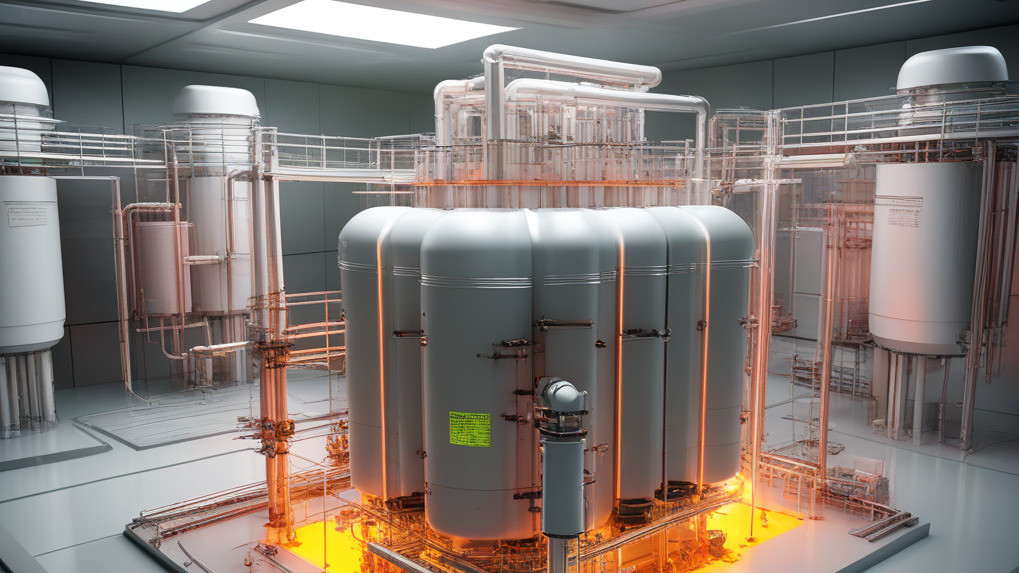At the World Climate Conference, COP28 (December 2023), in Dubai, six countries, namely France, the United Kingdom, the United States, Sweden, South Korea, and the United Arab Emirates (UAE), formed a united front for nuclear energy. They advocated for a tripling of global nuclear power capacity by the year 2050. In total, a group of more than 20 countries called for the expansion of nuclear power.
In this context, small modular reactors (SMRs) are emerging as a potential game-changer in the world of nuclear power. In our ongoing series exploring various energy sources, today we turn our attention to SMRs, examining their unique characteristics, benefits, and potential challenges.
SMRs in a Nutshell
Unlike their larger counterparts, SMRs are designed to generate less than 300 MW of electrical power each. Think of them as smaller, more manageable versions of traditional nuclear plants. What sets SMRs apart is their modular nature – they are factory-built, self-contained units that can be easily transported and assembled on-site. This modularity allows for phased implementation, making them adaptable to growing energy demands. Moreover, SMRs boast passive safety features, relying on physics-based mechanisms rather than complex fail-safe systems operated by humans.

Small Modular Reactors are Powering the Way to a Sustainable Energy Future
(symbol image, credit CLOU)
Design Advantages
The advantages of SMRs go beyond their compact size. The standardized construction and simplified safety features of SMRs aim to significantly reduce upfront capital costs compared to their larger counterparts, which can cost billions of dollars. This cost reduction opens up opportunities for deploying SMRs in isolated communities or industrial facilities where larger plants may not be economically viable. Additionally, SMRs require smaller support staff and occupy less physical space compared to gigawatt-scale reactors.
Technological Diversity
SMRs come in a variety of designs, employing different combinations of reactor coolant, such as light water, advanced gas, lead, sodium, or molten salt. While light water SMRs are currently at the forefront of commercial development, other technologies offer higher efficiencies, improved fuel utilization, and advanced waste management capabilities. The goal is to tailor SMR technology to meet the specific needs of different grids, industries, and missions worldwide.
Global Development
Around the world, various countries and companies are actively pursuing SMR development. For example, Nuward in Canada is on the verge of commissioning the world's first commercial light water SMR. In the United States, BWXT and Kairos Power are making strides in the development of gas-cooled designs. Russia's Rosatom has even constructed floating icebreaker-scale reactors, and China is advancing in the field of proliferation-resistant molten salt options. With promising economic viability and enhanced safety features, SMRs have the potential to regain nuclear power's standing as clean energy demand skyrockets in the coming decades.
The Road Ahead
While the promise of SMRs is enticing, there is still work to be done. Continued technological progress and early demonstration deployments will be critical in determining whether this promise can be fully realized. As with any emerging technology, careful evaluation of the economic, safety, and environmental aspects is crucial. However, if efficiency, scalability, enhanced safety, and economics align, SMRs could revitalize the nuclear power sector.
Key Considerations Surrounding SMRs
When it comes to small modular reactors (SMRs), there are a few considerations to keep in mind:
- Cost
While SMRs are expected to have reduced upfront capital costs compared to traditional nuclear plants, the exact economics of SMRs are still being explored. It's important to carefully evaluate the long-term costs of building, operating, and maintaining SMRs to ensure their economic viability. - Regulatory Challenges
As with any new technology, SMRs may face regulatory hurdles and licensing complexities. The unique characteristics of SMRs may require the development of new regulatory frameworks and safety standards, which can slow down their deployment and increase costs. - Waste Management
Although SMRs offer potential improvements in waste management compared to traditional reactors, the disposal of nuclear waste remains a challenge. It's essential to address the long-term storage and disposal of radioactive waste generated by SMRs to ensure the safety and sustainability of these systems. - Public Perception
Nuclear power has faced public scrutiny in the past due to safety concerns and the potential for accidents. SMRs must overcome public perception challenges and gain public acceptance to be widely adopted. Transparent communication about safety measures and risk mitigation strategies is crucial in building trust. - Scale and Scalability
While SMRs are designed for smaller-scale energy generation, their scalability remains a key consideration. Ensuring that SMRs can be efficiently scaled up to meet larger energy demands without compromising safety and cost-effectiveness will be important for their long-term viability.
It's important to note that these potential drawbacks should not overshadow the benefits that SMRs can offer in terms of enhanced safety, modularity, and potential economic advantages. Continued research, development, and careful planning are essential to address these challenges and maximize the potential benefits of SMRs.
Thank you for reading. If you would like to share your thoughts on this topic, please feel free to leave a comment below. We value your feedback and are always eager to hear from our readers.
Until then, keep shining bright like a solar panel on a sunny day!





All comments are moderated before being published. Inappropriate or off-topic comments may not be approved.